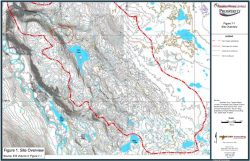Feds responsible for Fish Lake conflict, "Schedule 2" must be scrapped
BLOG POST posted on September 14, 2010 by dawn
It looks like we'll be waiting at least one more day for the spark that could explode into a raging fire of resistance surrounding a proposed gold and copper mine on unceded Tsilhqot’in territory. The Federal Minister of the Environment and his team were expected to announce today whether or not they're greenlighting Taseko's so called "Prosperity" mine.
This announcement is the next step after the federal review panel's report, which was issued in July. In their 300 page report, the Panel found that that Taseko's "Prosperity" mine would:
The Panel concludes that the Project would result in significant adverse environmental effects on fish and fish habitat, on navigation, on the current use of lands and resources for traditional purposes by First Nations and on cultural heritage, and on certain potential or established Aboriginal rights or title. The Panel also concludes that the Project, in combination with past, present and reasonably foreseeable future projects would result in a significant adverse cumulative effect on grizzly bears in the South Chilcotin region and on fish and fish habitat.
The panel found that two lakes, Teztan Biny (Fish Lake) and Y’anah Biny (Little Fish Lake), would be destroyed were Taseko's project to go ahead, killing 90,000 trout. The company has proposed to build a replacement lake, ironically called "Prosperity Lake," that may support up to 20,000 trout, but according to the Panel, "it would neither meet Fisheries and Oceans Canada No Net Loss policy nor provide assurance to First Nations that the fish would be safe for consumption." In addition, at least two kilometers of fish bearing streams would be adversely affected by the project.
The No Net Loss policy has been called Canada's oldest environmental legislation, designed to ensure that there is no net loss of fish habitat. But a 2002 amendment to a federal regulation, known as "Schedule 2" has allowed the government to reclassify fish bearing bodies of water as "tailings impoundment areas" so as to avoid DFO regulations. Two lakes have already been destroyed under Schedule 2, Fish Lake is one among 11 slated for destruction, five of which are in BC.
Taseko started the environmental assessment for the first time in 1994, and canned the project in 2000, due to low metal prices. In 2002, right in line with Schedule 2, they re-started the environmental assessment process. Without this regulatory maneuvering by the federal government, it's not likely that Taseko would ever have pushed ahead with the Prosperity mine. The company themselves have claimed that using Fish Lake for tailings disposal is the only profitable way for them to operate the mine.
The conflict surrounding the Prosperity mine is something that the federal government themselves have created (with assistance from the BC government and private capitalists), by introducing the Orwellian Schedule 2. The right thing for the government to do is painfully obvious: scrap the Prosperity mine, and scrap Schedule 2 altogether.
Water and life are worth more than gold, and for people on the land and their supporters, that's more than a slogan. It's something worth defending until the end.
The site for the Vancouver local of The Media Co-op has been archived and will no longer be updated. Please visit the main Media Co-op website to learn more about the organization.

Comments
Re: The simple truth
The Fish Lake/Prosperity mine casts light upon the sweeping powers granted under Schedule 2. See West Coast Environmental Law blog on the legality of Schedule 2: http://wcel.org/resources/environmental-law-alert/prosperity-mine-illegal
Re: The simple truth
The Fish Lake/Prosperity mine casts light upon the sweeping powers granted under Schedule 2. See West Coast Environmental Law blog on the legality of Schedule 2: http://wcel.org/resources/environmental-law-alert/prosperity-mine-illegal